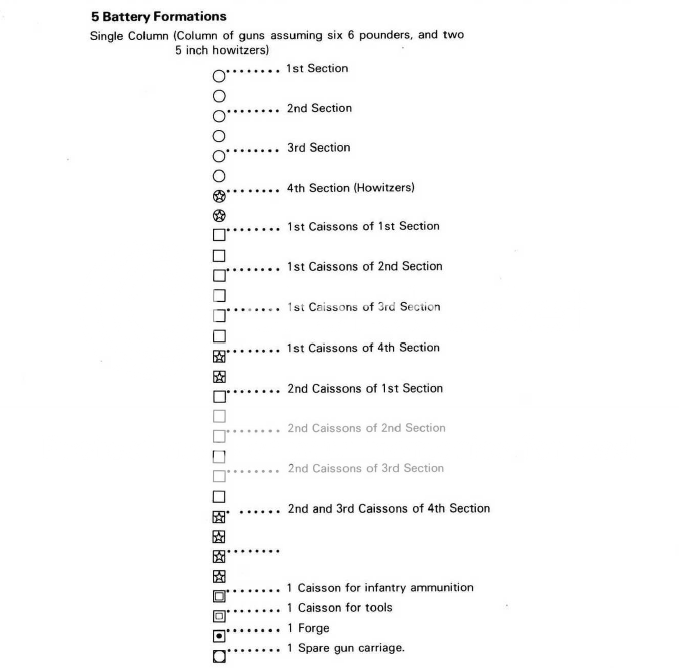FRENCH BATTERY TACTICS

THE FLYING BATTERY:The standard artillery tactic.Designed to take advantage of French artillery's mobility and training. A
battery would move to one area on the field, lay down a short, sharp barrage, then rapidly redeploy to another area and fire another barrage, then quickly redeploy again, etc. The combined, cumulative effect of numerous batteries doing this all along the enemy's lines could be devastating. The horse artillery were especially well suited for this tactic. Napoleon used it to great success in the Armée's early campaigns. Its flexibility allowed him to quickly mass well-aimed fire anywhere it was needed. But it
required superbly trained and conditioned artillerymen and horses as well as close command, coordination and control in order to work.
THE GRAND BATTERY :Artillery batteries were allocated at the divisional level for fire support..however manuevering individual batteries into flank attacks was not always feasible due to terrain,enemy numbers etc.The french increasingly used artillery on a wider scale as the number of combatants increased through the napoleonic wars a new tactic that came to be known as the grand battery.An alternative artillery tactic, when circumstances prohibited the flying batteries.
Artillery would mass its fire at a single, crucial point on the battlefield (usually against the enemy's centre). It could be devastating if the enemy was caught by surprise or in the open. But massing large numbers of guns in a single area without the enemy's knowledge could be tricky. Once the batterie opened fire and its target became clear, measures could be taken to avoid it. It was also vulnerable to counter battery fire from enemy artillery and needed protection from cavalry attack. Although this has become the most well known French artillery tactic, Napoleon preferred the flying batteries and used it only when he had to or thought it posed a better chance of success. Often at the start of a battle, he would mass batteries into a Big Battery, then after a few salvoes, break it up into flying batteries. In the early campaigns it was rarely used, but as the quantity of the Armée's horses and quality of its artillerymen declined, Bonaparte would be forced to employ it much more frequently in later battles.
The embryonic employment of grand batteries were noted at castiglione 1796 in italy and at marengo 1800.Both times marmont(artillery general) massed around 20 guns at a decisive point and time to create a breakthrough.Smaller grand batteries were employed at austerlitz 1805 and jena 1806.The first employment of a real grand battery came at friedland 1807 under senarmont(artillery general) massed 38 guns to turn the battle.From the post 1808 period with huge numbers of combatants enormous 100 gun batteries were employed.Towards the end the allies too employed grand batteries ,but in a more crude fashion.
THE ROLE OF THE ARMY ARTILLERY RESERVE:
Napoleon pioneered the use of the army level artillery reserve to be deployed only at the critical hour at the decisive point.His
elite imperial guard artillery which had the best gunners and triple ammunition provisions,and was mostly horsed played this role which was hitherto unknown in europe(batteries distributed amongst infantry).Napoleon would combine the organic artillery of the units from a sector in the battlefield with the freshly deployed guard artillery to create a massed grand battery to produce the breakthrough in that chosen sector.(fully explained later in napoleon's art of war section)
EMPLOYMENT OF THE GRAND BATTERY:
1] CASE STUDY 1: FRIEDLAND 1807

Just going to see the decisive role of artillery in some of napoleon's battles in a very rudimentary manner.Freidland phase
1.Lannes apparently isolated corps is attacked by bennigsen who
hopes to destroy it before reinforcements can arrive as lannes 25,000 men hold out in a desperate defense against bennigsen's 60,000-the french corps system and napoleon's battalion carre formation shows its strength.Rapid french reinforcements have arrived and
now napoleon outnumbers bennigsen who is in a false position with a river on his back and just a few bridges as his retreat path.Lannes flanks have been reinforced by mortier's corps and grouchy's cavalry on the left.And victor's corps and ney's arriving corps on the right.Imperial guard is the reserve under besseires.Napoleon has achieved superior concentration yet again,
his plan is a simple flank attack using ney's corps as the spearhead through the forest along with pinning attacks on the centre,to constrict the russian centre and left wing into the restricted horseshoe shaped space with their backs to the alle river and only a couple of bridges as the escape route.Grouchy and mortier will hold defensively on the left flank.Lannes exhausted corps will be rested.

2.Ney attacks but his attack is dispersed by the woods,russian artillery fire from across the river and platov's cossack attack.He is
forced back in disarray.At this point dupont's division of victor's corps is in the lead of the french right.Senarmont,divisional artillery commander of victor's corps sees an oppurtunity,obtains permission for victor to
mass all the guns(38) into a single battery and recklessly advances it slowly and methodically into the flank of the depressed russian left flank first into 200 metres then to a mere point blank range of 60 metres-into musket range!.Napoleon thought he was deserting!At this range the devastating canister fire blows out the russian left flank,the russian guard attempting to counterattack suffers the same fate.Senarmont lost a large number of his gunners and was himself wounded in this reckless artillery charge but single handedly turned the battle.

3.He doesn't stop there.After blowing out the russian left,he
suppresses the russian battery across the river and provides fire support to ney's regrouped forces as dupont and ney break through and storm friedland town and seize the bridges,The french win a decisive victory ending the war of the 4th coalition.
HOW HE DID IT -

Senarmont obtains permission to mass all the guns of victor's corps-38 in total.
4 heavy 12-pounders,4 light 4-pounders,8 howitzers and 22 medium 6-pounder pieces.Senarmont divided his guns into 3 provisional batteries- 2 main batteries each of 10 6-pounders,2 4-pounders and 4 howitzers.The heavy 12 pounders were held back in a reserve in a protected position.The 2 big batteries were
placed on 2 hillocks to obtain a crossfire with the reserve heavy battery from the back providing long range fire support.Fire opened at 400 metres but after 5-6 shots from the guns senarmont
advanced his batteries alternately(1 advancing while other firing) to a mere 200 metres,this audacious 'artillery charge' was escorted by 4 dragoon regiments and 1 infantry battalion.At 200 metres the 2 batteries fired about 20 roundshot from each gun and were beginning to have a telling effect.Senarmont ignored pleas for him to return to safer distance.Here however they were somewhat lucky in that
russian counter battery fire from across the river alle was not effective due to dense smoke and bad positioning which left part of their own troops in the field of fire of the guns.
At this juncture,senarmont joined both batteries together and
advanced into 60 metres!Here they opened up a devastating canister fire blowing out a hole in the russian line-4000 men killed in less than half an hour and survivors retreated.With the infantry retreating russian gunners too retired,the russian cavalry attempted a desperate charge but were repulsed by the escort and massed artillery fire from senarmont.He then proceeded to provide direct fire support to ney's attack on freidland town.Senarmont's virtuoso feat set a new standard in grand battery usage among french artillery commanders.
2] CASE STUDY 2 : WAGRAM 1809

Over 300,000 french and austrian troops battle for the fate of germany at wagram outside vienna.
Napoleon has accepted a highly risky battle with a river to his back.Under cover of night the 150,000+ french force crosses the danube and secures a beachhead from their staging base at the island of lobau.Initially decieved the alerted Archduke charles and his austrians are nowwaiting for them.It is day 2 of the battle.Napoleon's plan is a outflanking attack by his superb III corps under davout on the austrian left flank,while pinning attacks along the centre keep the austrian forces occupied.Should the austrians shift reserves to reinforce the left..he would unleash his reserves incluidng the imperial guard and breakthrough the weakened austrian centre.However the austrians attack first,
archduke charles plans an ambitious double envelopment that would shatter both french flanks and annihilate the whole french army with its rear to the river.Davout soon stops the attack on him cold on the french right,napoleon sends reinforcement to his right to davout but has them returned when it is clear davout has the situation under control.
At the centre the french attack by massena and bernadotte's corps on aderklaa have not made significant progress and cost heavy casualities.At this juncture the austrian right wing forces
the corps of Kollowrath and klenau begin their other pincer attack ,klenau sweeps aside boudet's small rearguard and heads straight for the french rear,while kollowrat threatens massena's already bloodied corps from the left.The
hour of crisis for the french has arrived.

Napoleon reacts in a bold and unconventional manner-
rather than dispatching the guard and his infantry reserve from his centre south to block klenau's advance,He orders massena's corps to
march south in full view of kollowrath advancing corps to act as a blocking force in klenau's advance.This is apparently a suicide move..massena would have to move with his flank exposed to kollowrath's advance to reach his position.Here napoleon
launches his heavy cavalry reserve at kollowrat to buy time in a costly but necessary spoiling attack with massed cavalry.Behind this distraction
he masses all the guns of the corps of the area and adds the reserve imperial guard artillery-the army artillery reserve to form a massive 102 gun grand battery under lauriston.(the long blue bar with a small tip in the centre behind the infantry assault semi square with written serras is the grand battery)Kolowrat's advancing force
runs straight into this grand battery and is met by a hail of relentless artillery bombardment..devastated, it is forced to retire in disarray.
Under the cover of this massena safely conducts his march and blocks any further advance from klenau.Meanwhile on the right davout's superb III corps slowly but inexorably turns the austrian left wing.With the austrian right wing's momentum exhausted,and left wing turned..
napoleon now releases his infantry reserve-one that he had preserved in a masterstroke rather than deploy earlier to prop up his left, formed in a gigantic semi-square and attacks the austrian centre.This attack is supported by the
french grand battery,and the combined assault at aderklaa and sussanbronn breaks through austrian resistance and wins the battle.


Wagram has been called the
first true artillery battle.Napoleon declared afterwards-
'My artillery has won the battle'.The grand battery was
used as both a disruptive and an assault tool.It stopped kollowrath's advance cold and covered massena's movement.Then it went on the offensive and pounded the austrian centre for the final push.However
casualities here were far larger than senarmont's,this huge exposed battery came under effective counter bombardment by the austrians and though its silenced its counterparts by volume of firepower..losses were high among the gun crews.Also the
infantry exploitation was slow and clumsy and diluted the effect of the bombardment.Nevertheless
wagram saw the first employment of the monstrous grand batteries of the late napoleonic period.
NEXT:
Case study Hanau 1813 & French artillery generals:French imperial guard:Napoleon's Art of war:Russian Army:Austrian Army - The campaign begins.









































